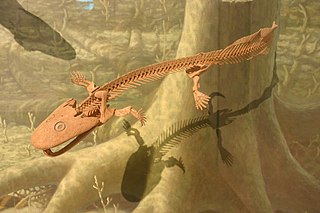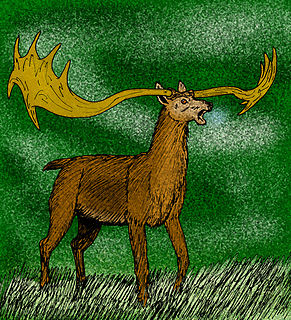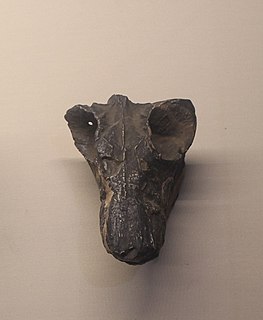 W
WAcanthostega is an extinct genus of stem-tetrapod, among the first vertebrate animals to have recognizable limbs. It appeared in the late Devonian period about 365 million years ago, and was anatomically intermediate between lobe-finned fishes and those that were fully capable of coming onto land.
 W
WDecennatherium is an extinct genus of giraffids. It was first named by Crusafont Pairo in 1952. It was only found at the Macrofauna, Los Valles de Fuentiduenya fossil site in Segovia, Spain.
 W
WEusthenodon is an extinct genus of prehistoric tristichopterids from the Late Devonian period, ranging between 383 and 359 million years ago. They are well known for being a cosmopolitan genus with remains being recovered from East Greenland, Australia, Central Russia, South Africa, and Belgium. Compared to the other closely related genera of the Tristichopteridae clade, Eusthenodon was one of the largest lobe-finned fishes and among the most derived tristichopterids alongside its close relatives Cabonnichthys and Mandageria.
 W
WLibralces was a genus of Eurasian deer that lived during the Pliocene epoch. Its main claim to fame are its 2+ meter wide antlers, comparable in size to those of Megaloceros.
 W
WProtorothyris is an extinct genus of Early Permian protorothyridid known from Texas and West Virginia of the United States. It was first named by Llewellyn Ivor Price in 1937 and the type species is Protorothyris archeri. P. archeri is known from the holotype MCZ 1532, a three-dimensionally preserved skull and from the referred specimens, which come from four additional individuals, MCZ 2147-2150. All specimens were collected in the Cottonwood Creek site, from the Archer City Formation, Texas, dating to the Asselian stage of the Cisuralian epoch, about 299–294.6 million years ago. A second species, P. morani, was first named by Alfred Sherwood Romer in 1952 with its own generic name, Melanothyris. In 1973, J. Clark and Robert L. Carroll recombined P. morani as a Protorothyris species. It is known from the holotype CM 8617, a three-dimensionally preserved skull. It was collected in the Blacksville site, from the Washington Formation of West Virginia. Protorothyris was the size of the average lizard, about 30 cm in length.
 W
WPiveteauia is an extinct genus of prehistoric coelacanth fish which lived during the Lower Triassic period. The genus is named for twentieth century French vertebrate paleontologist Jean Piveteau. The type specimen was discovered in the Middle Sakamena Group in northwestern Madagascar by French paleoichthyologist Jean-Pierre Lehman.
 W
WProtorothyris is an extinct genus of Early Permian protorothyridid known from Texas and West Virginia of the United States. It was first named by Llewellyn Ivor Price in 1937 and the type species is Protorothyris archeri. P. archeri is known from the holotype MCZ 1532, a three-dimensionally preserved skull and from the referred specimens, which come from four additional individuals, MCZ 2147-2150. All specimens were collected in the Cottonwood Creek site, from the Archer City Formation, Texas, dating to the Asselian stage of the Cisuralian epoch, about 299–294.6 million years ago. A second species, P. morani, was first named by Alfred Sherwood Romer in 1952 with its own generic name, Melanothyris. In 1973, J. Clark and Robert L. Carroll recombined P. morani as a Protorothyris species. It is known from the holotype CM 8617, a three-dimensionally preserved skull. It was collected in the Blacksville site, from the Washington Formation of West Virginia. Protorothyris was the size of the average lizard, about 30 cm in length.
 W
WRiebeeckosaurus is an extinct genus of tapinocephalian therapsids from the Guadalupian epoch of Middle Tapinocephalus Zone, lower Beaufort Beds of the Karoo, in South Africa. Only two skulls are known from the type genus.
 W
WSarcoprion is an extinct genus of eugeneodontid holocephalids from the Permian of Greenland. Similar to other eugeneodontids such as Edestus and Helicoprion, it was best known for its extremely bizarre tooth morphology compared to other species of sharks and their closest relatives, the chimaeras. Compared to other members of the Helicoprionidae, its "tooth whorls" were found to be sharper, more compact, and in better condition than other sharks of the time, and refrained from growing to extremely unwieldy forms that would raise questions about its ability to feed properly. The genus contains one species, Sarcoprion edax, found in Permian-aged marine strata of Meddelelser om Grønland.
 W
WTalarurus is a genus of ankylosaurid dinosaur that lived in Asia during the Late Cretaceous period, about 96 million to 89 million years ago. The first remains of Talarurus were discovered in 1948 and later described by the Russian paleontologist Evgeny Maleev with the type species T. plicatospineus. It is known from multiple yet sparse specimens, making it one of the most well known ankylosaurines, along with Pinacosaurus. Elements from the specimens consists of some bones from the body, however, five skulls have been discovered and assigned to the genus, although the first two were very fragmented.
 W
WUrumchia is an extinct genus of therocephalian therapsids from the Early Triassic of China. The type species Urumchia lii was described by Chinese paleontologist C. C. Young in 1952 from the Jiucaiyuan Formation in Xinjiang. The holotype skull has been lost, but Young was able to describe the species on the basis of a detailed cast of the skull. Urumchia is similar to the South African therocephalian Regisaurus in having an expanded pair of vomer bones on the underside of the skull that form a secondary palate. In Urumchia the front end of the vomers narrow to a point, while in Regisaurus they do not. Urumchia has six incisors on either side of the upper jaw, a primitive condition among baurioid therocephalians that usually have fewer incisors.
 W
WXenungulata is an order of extinct and primitive South American hoofed mammals that lived from the Late Paleocene to Early Eocene. Fossils of the order are known from deposits in Brazil, Argentina, Peru, and Colombia. The best known member of this enigmatic order is the genus Carodnia, a tapir-like and -sized animal with a gait similar to living African elephants.